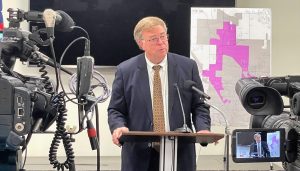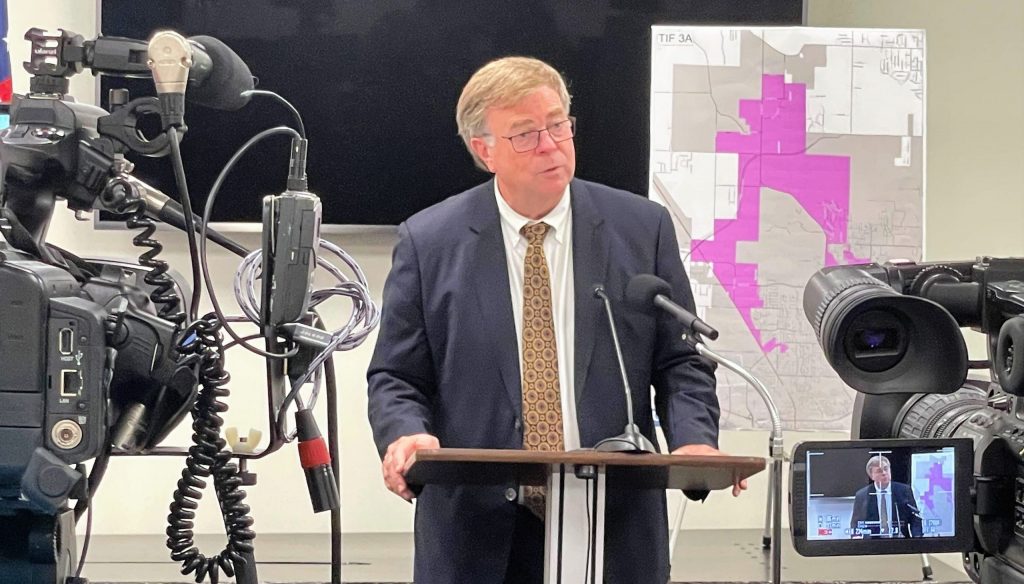Mayor Battle announces TIF closure, highlights benefits to schools, businesses
Published on July 27, 2022

The City of Huntsville’s sound fiscal footing will be on display again next month when it retires its third tax increment financing district, or TIF, two years ahead of projection and nine years before its required closing.
The early payoff aligns with Mayor Tommy Battle’s push for smart planning and fiscal prudence, both of which have helped Huntsville secure and maintain AAA bond ratings from Moody’s and Standard & Poor’s. The City will pay off the outstanding warrants to close the TIF in mid-August.
“Our capacity to borrow and take on more debt is a sign to the rating agencies and our investors that Huntsville is a good place to do business,” Mayor Battle said. “Closing our third TIF district is also a great indicator that we’re continuing to head in the right direction.”
About TIF 3A
Created in 2001, TIF 3A was projected to end in 2024. Projected to-date taxes for the TIF were $37.4 million, but taxes collected totaled more than $46.2 million for a performance rate of 23.7% (collected taxes over projections).
CLICK HERE TO SEE THE PRESENTATION FROM THURSDAY’S CITY COUNCIL MEETING.
TIFs are a key factor in both job creation and infrastructure improvements. Mayor Battle said TIF 3A was noteworthy because it allowed eight schools in Northwest Huntsville – Johnson High, Rolling Hills Elementary, West Mastin Lake Elementary, ASFL/Davis Hills Elementary/Middle, Ed White Middle, Highlands Elementary and Lakewood Elementary – to make $12 million in capital improvements.
“This TIF is an example of how great investments ultimately go back into our schools and provide the best education possible,” Mayor Battle said. “It not only improved education, but it also provided thousands of jobs at the North Huntsville Industrial Park.”
Finance Director Penny Smith described these benefits as generational because they not only impact students and workers now, but they’ll also be felt far into the future. She also said paying off debt and closing the TIF early is indicative of the City’s due diligence.
“It really shows we’re planning to meet the demands of a growing City,” she said. “Not only did we pay off our debt for capital projects on time, but we paid it off early. That funding now goes back into the community and benefits our schools and creates jobs.”
TIF benefits
The City has opened eight TIFs since 2000, and TIF 3A is the third to close. TIFs contribute directly to continued growth and public improvements because municipalities can borrow money for projects within a designated district and then repay bonds using property tax proceeds.
“They allow us to make an investment in an area through infrastructure, schools and attracting and retaining businesses,” Smith said. “It raises the overall value of the properties, and it’s a great way for us to invest in our community.”
The origins of TIF 3A began in 1999 with the purchase of 500 acres to build North Huntsville Industrial Park (NHIP). Two years later, Toyota Motor Manufacturing purchased a substantial portion of the property to erect its first North American V8 engine plant.
Anticipating additional tenants at the NHIP, the City created TIF 3A in 2001. The 5,600-acre TIF includes the park and surrounding areas. In the years since, Toyota expanded its footprint through additional expansions and the park welcomed new tenants, Meta and Aerojet Rocketdyne. TIF 3A also provided more than $13 million in infrastructure improvements at the park.
Click here to learn more about TIF 3A and read the City’s latest TIF report.

